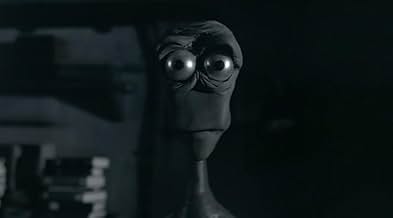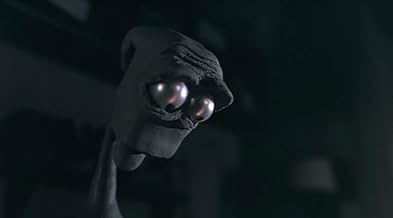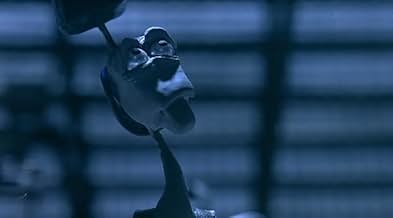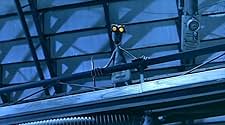More
- 1998
- 6m
IMDb RATING
8.1/10
6.3K
YOUR RATING
A factory worker creates a pair of goggles that puts its wearer in a state of bliss. But is that true happiness?A factory worker creates a pair of goggles that puts its wearer in a state of bliss. But is that true happiness?A factory worker creates a pair of goggles that puts its wearer in a state of bliss. But is that true happiness?
- Director
- Writer
- Nominated for 1 Oscar
- 9 wins & 3 nominations total
Featured reviews
10llltdesq
George Santayana, call your answering service. This is a perfect example of what he was talking about with history repeating, if on a smaller, more localized, scale. Watch this carefully and you'll see what I'm talking about. This lost to Bunny for Animated Short, which I'm certain Bunny won because it is a more visually stunning cartoon. Given that both have a lot going for them in terms of intent, plot, ideas and eloquence, I suspect More could have won if Bunny hadn't been visually incredible. Personally, I wish there had been a tie between them. There is certainly nothing for either of these magnificent shorts to be sorry about and both deserve praise and a wider audience. More is solid in all respects-animation, backgrounds, story, music and so on. In most years, probably a winner of record. Given how precious little recent short animation is in print at the moment (very little), an audience for More is preferable to any award, in any case. Too bad that there isn't perceived to be much of a market for things like Bunny and More. It may not be huge, but a market does exist. If you can see More, by all means, do so. Most Highly Recommended.
...because films like "More" really deserve it.
This is the kind of work that makes me want to quit my job and learn stop-action animation. It's amazing how much life you can infuse into a simple construction of clay-and-wire with a camera.
The world needs more short films like this! Let's start a petition to have a short flick preceding EVERY feature film. (Maybe that would make the $8 ticket price less of a punch in the eye.)
This is the kind of work that makes me want to quit my job and learn stop-action animation. It's amazing how much life you can infuse into a simple construction of clay-and-wire with a camera.
The world needs more short films like this! Let's start a petition to have a short flick preceding EVERY feature film. (Maybe that would make the $8 ticket price less of a punch in the eye.)
One of the most beautiful and poignant animated shorts I've ever seen, if not the most. Unfortunately, I got to see it only once and didn't get a chance to fully take it in, and there was definitely a lot there to take in. Some beautiful animation and a beautiful story about what happiness really is. Full of symbolism and a look at a future which may not be far off. Shows that happiness doesn't come in a box or any other sort of artificial means. Something which most of the world doesn't and probably never will get.
10dynea
Everyone wants, expects, and demands more and more each day. We think we will get happier and richer by asking, giving and getting more. Are we though? Where is this taking us? This short film is very thought provoking. One can interpret it in multiple levels: political, religious, social etc. Politically there is subtle undermine of how it is almost impossible to rebel against the system. The workers of a factory in this film representing the workers of a capitalistic country who are like ants working their lives off in being productive and efficient to satisfy the demand of their consumptive society. These 'aunts' being controlled and pressured by others above them get worn out, ending up neglecting the meaning of life. Consequently, life seems dark, just like the colors of the film.
The religious implication is the sacrifice of the one for the benefit of the whole. In Christianity, Jesus Christ gave up his life to salvage humanity from the darkness of sin. In this short film, the main character gives up himself to salvage humanity from darkness. He opens 'the door' of his abdomen as if it was the gateway to his soul, taking out and giving to humanity the most precious part of his existence; his colorful soul. That is what it takes to make a change in our society.
As about the social implications, they are multiple. One of which is the monotonous routine the average blue-collar worker has in a developed capitalistic country. Waking up in the morning, going to work, doing repetitious work, getting pressured by the boss, going back home to sleep and repeat the same the next day and feel like nobody among the millions others.
In addition, regardless of the social status of each person, every adult is assigned with certain responsibilities and is expected to behave in a certain manner. Adults are not carefree and cannot act freely upon their feelings. Therefore, dreaming becomes a rescue zone. One is truly free in dreams, thus happy. The main character dreams about his childhood, the time he was carefree and happy. Becoming so nostalgic of the colorful times of his past, he turns into a restless and rebellious person, yearning to bring change into his dark world. He is determined to bring color and happiness back to life, regardless of the cost.
The cost of dreams is a notion highlighted by the director. Everyone has dreams. The demanding society we live in however, does not give us a lot of space to act upon them for free. Those who act upon them, have to sacrifice their lives in one way or another, whether that is the psychological, personal, financial, or even the physical aspect of their lives. How many get sick physically or psychologically from stress running after their dreams? How many drown in debt investing in their dreams? How many spend less and less time with their loved ones ending up losing them to get closer to their dreams? No one can make a dream come true without paying a price for it.
The main character ends up giving up his entire existence, body and soul, to bring this change in his world. His body represented as a piece of coal, and his spirit represented by the brightness of the red color coal which brought brightness, color, and happiness back to the world. It is interesting to note how the memories of his carefree, naive, and happy childhood has the same color as the pieces of the coal representing his soul.
The bottom line is that the main character succeeded in bringing change. Color and happiness was brought back to the world. However, the price was more than he expected. It cost him his life. Was it worth it? Probably it was for him. He finally sensed the almost forgotten feeling of happiness outside his dreams. He once again saw color in life - a notion pertained only to childhood before his sacrifice. Not only did he make himself happy, but he also endowed everyone else with happiness. He saved humanity from darkness. The question is what will happen after him? Will the rest of the individuals get inspired by him and follow his steps or are they going to follow the flock already organized for them for a dark, monotonous, meaningless ride on the road of life. It is a personal decision whether one will live to work or work to live. Which of the two one will get more of, is up to the individual!
The religious implication is the sacrifice of the one for the benefit of the whole. In Christianity, Jesus Christ gave up his life to salvage humanity from the darkness of sin. In this short film, the main character gives up himself to salvage humanity from darkness. He opens 'the door' of his abdomen as if it was the gateway to his soul, taking out and giving to humanity the most precious part of his existence; his colorful soul. That is what it takes to make a change in our society.
As about the social implications, they are multiple. One of which is the monotonous routine the average blue-collar worker has in a developed capitalistic country. Waking up in the morning, going to work, doing repetitious work, getting pressured by the boss, going back home to sleep and repeat the same the next day and feel like nobody among the millions others.
In addition, regardless of the social status of each person, every adult is assigned with certain responsibilities and is expected to behave in a certain manner. Adults are not carefree and cannot act freely upon their feelings. Therefore, dreaming becomes a rescue zone. One is truly free in dreams, thus happy. The main character dreams about his childhood, the time he was carefree and happy. Becoming so nostalgic of the colorful times of his past, he turns into a restless and rebellious person, yearning to bring change into his dark world. He is determined to bring color and happiness back to life, regardless of the cost.
The cost of dreams is a notion highlighted by the director. Everyone has dreams. The demanding society we live in however, does not give us a lot of space to act upon them for free. Those who act upon them, have to sacrifice their lives in one way or another, whether that is the psychological, personal, financial, or even the physical aspect of their lives. How many get sick physically or psychologically from stress running after their dreams? How many drown in debt investing in their dreams? How many spend less and less time with their loved ones ending up losing them to get closer to their dreams? No one can make a dream come true without paying a price for it.
The main character ends up giving up his entire existence, body and soul, to bring this change in his world. His body represented as a piece of coal, and his spirit represented by the brightness of the red color coal which brought brightness, color, and happiness back to the world. It is interesting to note how the memories of his carefree, naive, and happy childhood has the same color as the pieces of the coal representing his soul.
The bottom line is that the main character succeeded in bringing change. Color and happiness was brought back to the world. However, the price was more than he expected. It cost him his life. Was it worth it? Probably it was for him. He finally sensed the almost forgotten feeling of happiness outside his dreams. He once again saw color in life - a notion pertained only to childhood before his sacrifice. Not only did he make himself happy, but he also endowed everyone else with happiness. He saved humanity from darkness. The question is what will happen after him? Will the rest of the individuals get inspired by him and follow his steps or are they going to follow the flock already organized for them for a dark, monotonous, meaningless ride on the road of life. It is a personal decision whether one will live to work or work to live. Which of the two one will get more of, is up to the individual!
Wow. Who would have thought the entire meaning of life could be summed up in 6 minutes. The greatest of this film is its greatest irony, considering it questions the worth of success based on material wealth. The piece fits its soundtrack (Elegia by New Order) excellent as well. It's a shame this short lost out in the 1998 Oscars, I'd like to think that the voters had a chance to see it before deciding (although they probably didn't.) A definite 10.
Did you know
- TriviaAwarded the Best Short Film at the 1999 Sundance Film Festival.
- Alternate versionsThe film was re-edited and released as a music video for the song "Hell Bent" by Kenna.
- ConnectionsFeatured in Film-Fest DVD: Issue 2 - Cannes (1999)
- SoundtracksElegia
Written, Produced and Performed by New Order
Details
- Runtime6 minutes
- Color
- Aspect ratio
- 1.44 : 1
Contribute to this page
Suggest an edit or add missing content


















